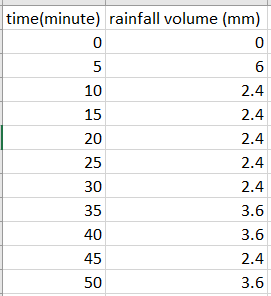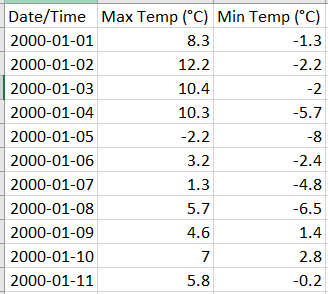VO supports various climate files in Resource Library.
READ Storm File (*.stm)
This is the storm file used by OTTHYMO-89/INTERHYMO READ STORM command. In VO5, it is used to create a read-in design storm in Resource Library. The file format is described below.
1st line: 2 (1 indicates in/hr, 2 indicates mm/hr)
2nd line: comment line (up to 60 characters in length)
3rd line: 10 (storm time step, min)
4th line: 24 (number of rainfall increments)
5th line: 2.071 (1st rainfall intensity)
6th line: 2.266 (2nd rainfall intensity)
7th line: 2.524 (3rd rainfall intensity)
…th line: …
xth line: 2.135 (xth and last rainfall intensity, x corresponds to the number in the 4 th line)
last line: -1 (indicates the end of the file).
An example of a Storm data file (25mm4hr.stm) is as follows:
2
TWENTY-FIVE MM FOUR HOUR CHICAGO STORM
10
24
2.071
2.266
2.524
2.880
3.382
4.175
5.696
10.777
50.214
13.366
8.286
6.295
5.194
4.466
3.949
3.560
3.252
3.010
2.799
2.622
2.476
2.346
2.233
2.136
-1
MASS STORM File (*.mst)
This is the storm file used by OTTHYMO-89/INTERHYMO MASS STORM command. In VO5, it is used to create a MASS storm in Resource Library. The file format is described below. Note that the ordinate is the fraction of the accumulated rainfall volume to total volume. So it starts from 0 and increases to 1.
1st line: comment line (up to 60 characters in length)
2nd line: 20 (the time increment between each ordinate, min)
3rd line: 13 (the # of ordinates used to describe the mass curve, max.=400)
4th line: 0.00 (the first ordinate of the mass curve)
5th line: 0.01 (the second ordinate of the mass curve)
6th line: 0.04 (the third ordinate of the mass curve)
…th line: …
xth line: 1.00 (xth and last ordinate of the mass curve)
last line: -1 (indicates the end of the file).
An example of a MASS Storm data file (aesmass.mst) is as follows:
AES MASS CURVE DATA WITH TWENTY MINUTE TIME STEP
20
13
0.00
0.01
0.04
0.12
0.27
0.55
0.70
0.82
0.90
0.95
0.98
0.99
1.00
-1
Simple CSV
For single-event simulation, CSV file is used to import the precipitation. For continuous simulation, CSV file is used to import the precipitation, temperature, and evaporation data. The continuous simulation only supports certain time steps. For precipitation, it is 5min, 10min, 15min, 20min, 1hr and 1day. For temperature and evaporation, it is 1day.
Two columns are required for precipitation and evaporation. The daily temperature file has three columns with date time, minimum daily temperature, and maximum daily temperature. The first row of the CSV file is the column header and will not be read. For single-event design storm, the first column is in minutes and it is suggested to have the data starting from 0 minute. For continuous climate data, the first column is in a format of “year-month-day”.
An example of single-event rain data in CSV file is shown as below. Please download the CSV file template of single-event rainfall data.

An example of continuous rain data in CSV file is shown as below. Please download the CSV file template of continuous rainfall data.

An example of continuous temperature data in CSV file is shown as below. Please download the CSV file template of continuous temperature data.



